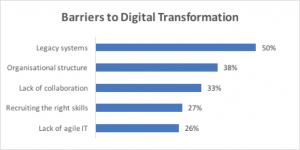Nimbus Ninety’s research, in partnership with Ensono, identifies leadership and vision as large contributors to failed digital transformation projects.
On the 21st March Nimbus Ninety, the UK’s independent research community for disruptive business and technology leaders, have released their latest research into digital transformation in partnership with Ensono, leading cloud solutions and Hybrid IT services provider. The Digital Trends Report interviewed 251 senior stakeholders responsible for digital transformation initiatives and found that 36% view increased competition from digitally driven companies as a challenge, yet more than half (52%) of respondents rated their organisations’ progress toward achieving their digital ambitions as adequate or poor.
The report, which reviews forces and barriers to digital transformation, revealed that 30% still do not feel well-equipped to seize the opportunities presented by digital. Conversely, 46% stated their organisation has significantly transformed over the past 12 months, suggesting a widening gap between those who are embracing digital transformation and those who have yet to start.
The report also measured barriers to digital transformation, with legacy systems taking an overwhelming lead in blocking progress.

Responding to the legacy issue, Simon Ratcliffe, Principal Consultant at Ensono says: “Although legacy systems are often cited as a barrier to transformation, they are, in fact, an enabler. Legacy systems need not be replaced to achieve transformation, they need to be factored into the execution. Progressive organisations are building new, transformational solutions in parallel with their legacy systems and slowly switching business operations across. Legacy IT and modern cloud-based solutions can co-exist and ignite the transformational journey.”
[easy-tweet tweet=”27% do not have a clear digital strategy.” hashtags=”Digital, Technology “]
The research also found that 39% of respondents are still in the process of developing their digital strategy compared to only 29% having one in place. A further 27% do not have a clear digital strategy communicated across the entire business. Instead, separate departments have formulated their own strategies. This decentralised, reactive approach results in pockets of digital success that are difficult to measure and replicate across the business. Inevitably, these organisations will struggle to defend their market position against this with a more formulated digital strategy.
The report highlighted issues of leadership and vision as large contributors to failed digital transformation projects. A broader cultural change is necessary for digital transformation to succeed. Nimbus Ninety’s findings on the reasons for failed projects rebukes the notion that technology changes the culture, and instead shows that technology only enables culture to change. Simply implementing the technology and expecting it to work without supporting a culture change through strong leadership, vision and HR dramatically reduces the chance of a successful digital transformation.
[easy-tweet tweet=”Technology alone does not drive digital transformation.” hashtags=”Technology”]
Simon added: “Technology alone does not drive digital transformation. Digital transformation is only truly effective when an organisation embraces it completely and reshapes the way it thinks and acts. Digital transformation is the perfect opportunity for IT to step up and take control of the strategic agenda but for this to be an effective approach, all parts of the business need to be engaged before any technology is adopted.”
The Digital Trends Report 2017 illustrates the importance of planning the journey to business transformation and the technology needed to facilitate it. Jessica Thorpe, senior research analyst at Nimbus Ninety says: “At the beginning of any business transformation process, it is important to understand what IT assets are already in the business, what they do and what value they deliver. From here, you can work out the best approach to operating today and optimising for tomorrow. Working in partnership with an expert provider of digital transformation will enable organisations to deploy agile delivery techniques and spend the precious budget on technology that delivers the fastest time to value, while also makes the best of their existing assets. Only then will businesses keep pace with their customers’ expectations and drive operational efficiency.”
To download the full report, please visit: https://www.ensono.com/downloads/uk/digital-trends-2017
Marketing Manager for Compare the Cloud



